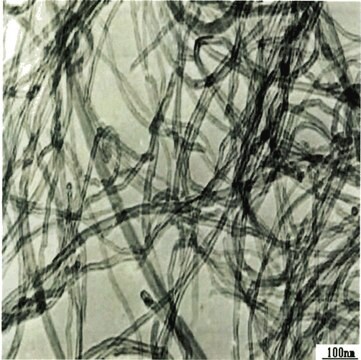755133
Kohlenstoffnanoröhrchen, mehrwandig
thin, <5% Metal Oxide(TGA)
Synonym(e):
MWCNT, MWNT, Mehrwandiges Kohlenstoffnanoröhrchen
About This Item
Empfohlene Produkte
Form
powder
Mittlerer Durchm. × L
9.5 nm × 1.5 μm , TEM
Verunreinigungen
<5% Metal Oxide (TGA)
mp (Schmelzpunkt)
3652-3697 °C (lit.)
Dichte
~2.1 g/mL at 25 °C (lit.)
Suchen Sie nach ähnlichen Produkten? Aufrufen Leitfaden zum Produktvergleich
Allgemeine Beschreibung
Anwendung
Electronics
Sensors
Composites
Energy Storage
Study of Life Science system
Angaben zur Herstellung
Rechtliche Hinweise
Lagerklassenschlüssel
11 - Combustible Solids
WGK
WGK 3
Flammpunkt (°F)
Not applicable
Flammpunkt (°C)
Not applicable
Hier finden Sie alle aktuellen Versionen:
Besitzen Sie dieses Produkt bereits?
In der Dokumentenbibliothek finden Sie die Dokumentation zu den Produkten, die Sie kürzlich erworben haben.
Kunden haben sich ebenfalls angesehen
Artikel
3D printing is a type of additive manufacturing that can be used to rapidly fabricate components with highly customizable geometries.
Boron nitride nanotubes (BNNT) are close structural analogs of carbon nanotubes (CNT), which are high aspect ratio nanotubular material, where carbon atoms are alternately substituted by nitrogen and boron atoms.
Carbon nanotubes (CNTs) have received much attention since their discovery in 1991 by Sumio lijima1 due to their excellent mechanical, electrical, and optical properties.
A nanocomposite is typically defined as a mixture between a host material (e.g., polymer matrix) and nanofillers with at least one dimension of less than 100 nm.
Unser Team von Wissenschaftlern verfügt über Erfahrung in allen Forschungsbereichen einschließlich Life Science, Materialwissenschaften, chemischer Synthese, Chromatographie, Analytik und vielen mehr..
Setzen Sie sich mit dem technischen Dienst in Verbindung.





